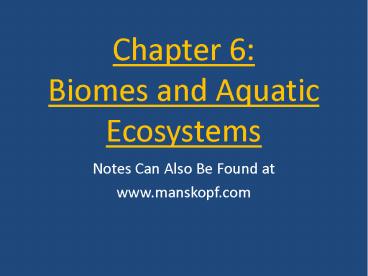Chapter 6: Biomes and Aquatic Ecosystems - PowerPoint PPT Presentation
Title:
Chapter 6: Biomes and Aquatic Ecosystems
Description:
Chapter 6: Biomes and Aquatic Ecosystems Notes Can Also Be Found at www.manskopf.com Temperate Rainforest Where on Earth? Small Biomes in Area Small Pockets ... – PowerPoint PPT presentation
Number of Views:645
Avg rating:3.0/5.0
Title: Chapter 6: Biomes and Aquatic Ecosystems
1
Chapter 6 Biomes and Aquatic Ecosystems
- Notes Can Also Be Found at
- www.manskopf.com
2
Chapter 6 Notes Goal
- Explain what biomes and aquatic ecosystems are
- Explain how biomes are characterized.
- Describe how net primary productivity varies
among biomes. - Give an introduction to your Biome Project
- Give an example of your Biome Project
3
What are the differences?Climate, Biology,
Limiting Factors, Adaptations?
4
Things Change?
- Fossil evidence suggests that the frozen
continent of Antarctica was once covered in
temperate forest.
5
Earths Biomes
- Groups of terrestrial ecosystems that share
biotic and abiotic conditions - 10 primary biomes
- tropical rain forest
- dry forest savanna
- desert
- temperate rain forest
- temperate forest
- temperate grassland
- chaparral
- boreal forest
- tundra
6
(No Transcript)
7
(No Transcript)
8
(No Transcript)
9
(No Transcript)
10
(No Transcript)
11
La Mesa, CA
12
Philadelphia
13
(No Transcript)
14
- Climate Average conditions, including
temperature and precipitation, over long periods
of time in a given area - Weather Day-to-day conditions in Earths
atmosphere - Climatographs Diagrams that summarize an areas
average monthly temperature and precipitation - Each biome has a set of characteristic organisms
adapted to its particular climate conditions.
15
Across the U.S.
16
Productivity
- Net primary production The amount of organic
matter (biomass) that remains after primary
producers use some to carry out cellular
respiration - Ecosystems vary in their net primary
productivity, the rate at which primary
producers convert energy to biomass. - Warm, wet biomes generally have higher net
primary productivity than cold, dry biomes.
17
(No Transcript)
18
Earths productivity On land forests are highly
productive in dark green, deserts least in brown.
At sea, red indicates high productivity and deep
oceans dark blue.
19
(No Transcript)
20
Aquatic Ecosystems (Wet Biomes)
- 75 of Earths surface is covered by water.
21
- Salinity the amount of dissolved salt present in
water. Ecosystems are classified as salt water,
fresh water, or brackish depending on salinity. - Photosynthesis tends to be limited by light
availability, which is a function of depth and
water clarity. - Aquatic ecosystems are either flowing or
standing. - Aquatic ecosystem zones photic, aphotic, benthic
22
Aquatic Ecosystem Limiting Factors
- Limiting factors may include
- Salinity
- Ph
- Sunlight
- Dissolved oxygen
- Temperature
23
Freshwater Ecosystems Ponds, Lakes, Inland Seas
- Salinity is less than 0.5 ppt (parts per thousand)
24
Freshwater Ecosystems Wetlands
- Areas of land flooded with water at least part of
the year - Include freshwater marshes, swamps, bogs, and
fens
25
Freshwater Ecosystems Rivers and Streams
- Bodies of surface water that flow downhill,
eventually reaching an ocean or inland sea
Delaware Water Gap
26
Estuaries
- Occur where a river flows into the ocean or an
inland sea - Coastal estuaries are brackish ecosystems
organisms must tolerate wide salinity and
temperature ranges. - Coastal estuaries are home to salt marshes and
mangrove forests.
27
(No Transcript)
28
Oceans
- Intertidal Areas
- Neritic Zones
- Open Ocean
29
(No Transcript)
30
Chapter 6 Review
- Explain what biomes and aquatic ecosystems are
- Explain how biomes are characterized.
- Describe how net primary productivity varies
among biomes. - Give an introduction to your Biome Project
- Give an example of your Biome Project
31
Biome Project Online
- http//www.manskopf.com/yahoo_site_admin/assets/do
cs/BiomesProject.230105729.doc
32
Biome Project PowerPoint Example
- Temperate Rain Forest
- JUST AN EXAMPLE 2-5 minutes
- Remember 60 for information
- Also found at www.manskopf.com
33
Temperate Rain Forest
- For Mr. Manskopf
- Environmental Science Class
- By Mr. Manskopf
- November 2011
34
Temperate RainforestWhere on Earth?
- Small Biomes in Area
- Small Pockets Around World
35
Temperate Rain Forests Locations
- Mid-Latitudes
- Usually near coastline
- Largest found in Pacific Northwest of U.S. and
British Columbia in Canada
36
Climate of the Temperate Rain Forest
- WET, Year Round Rain
- Moderate Temperatures
37
Why is it wet year round?
38
Species Found In Temperate Rain Forest
- TREES
- Cedars, Spruce, Hemlock, Douglas Fir
- Grow Tall/Fast
- Evergreens
- Coniferous Trees (seed-bearing cones)
- Compete for sunlight
- Commercially important
39
Species Found In Temperate Rain Forest
- Damp conditions perfect for moss
- Slugs
- Numerous amphibian creatures
- Squirrels
- Deer
- Elk
40
Species Found In Temperate Rain Forest
- Limiting Factors
- Sunlight
- Too much precipitation (Precipitation in
Olympic's rain forest ranges from 140 to 167
inches (12 to 14 feet) every year.)
41
Threats
- Timber/Logging
42
Example Hoh Rain Forest
- http//www.nps.gov/olym/naturescience/temperate-ra
in-forests.htm
43
Temperate Rain ForestCites
- http//www.nps.gov/olym/naturescience/temperate-ra
in-forests.htm - https//biomesfirst09.wikispaces.com/TemperateRai
nforestHome - http//www.marietta.edu/biol/biomes/temprain.htm































